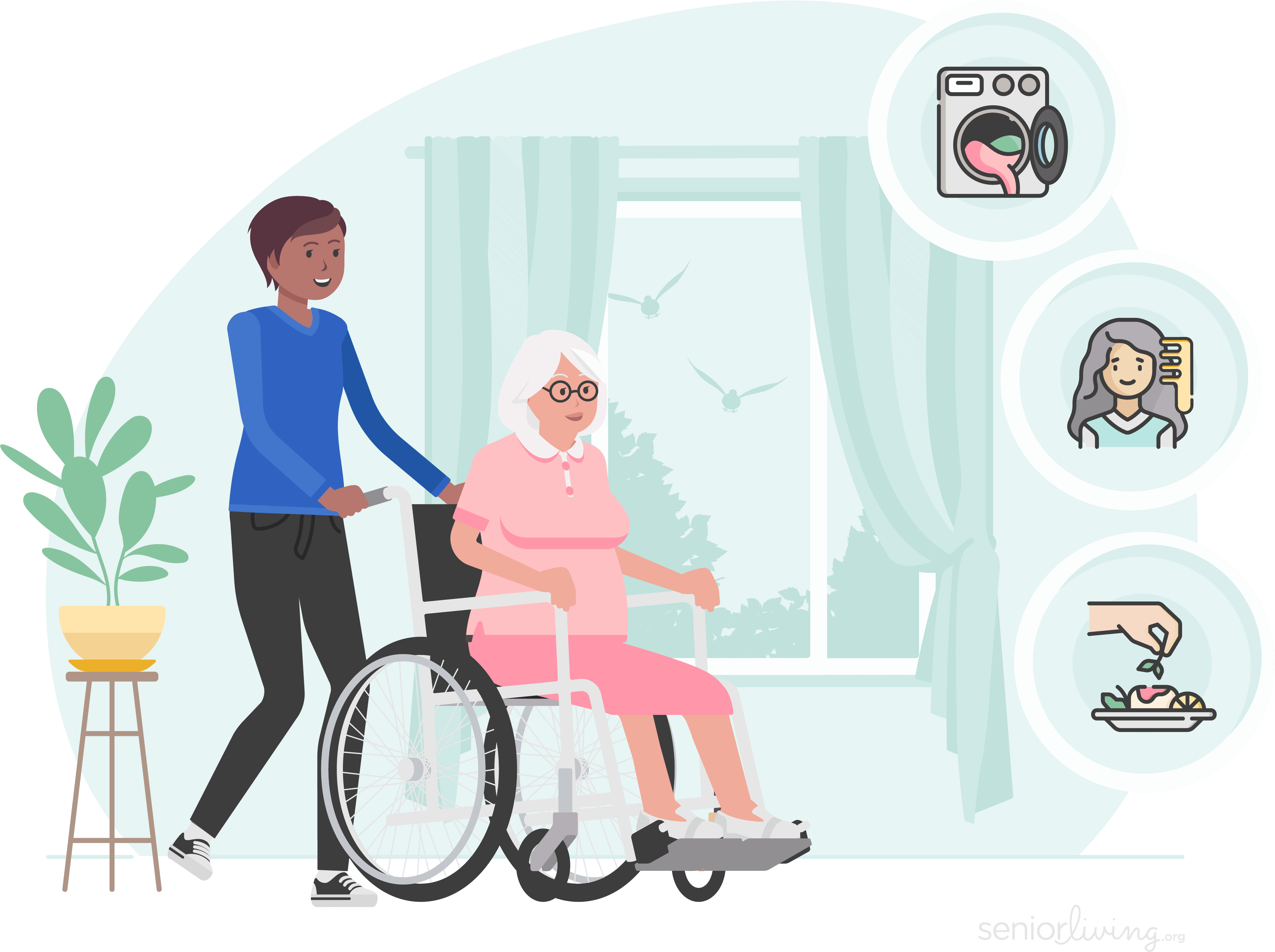Assisted Living for Seniors with Disabilities
Assisted living and other care facilities can provide the level of care that seniors with disabilities need for safe and fulfilling lives.
SeniorLiving.org is supported by commissions from providers listed on our site. Read our Editorial Guidelines
Find Disability Accommodating Assisted Living Near You
Join 200,448 Families Who've Found Assisted Living Communities on SeniorLiving.org.
Or Call: (855) 241-1699Find Disability Accommodating Assisted Living Near You
Older adults with disabilities face challenges every day that others often don’t understand or even think about. The most common types of disabilities make walking or living independently difficult.1 Assisted living, a level of care one step up from independent living, can help these older adults age as safely and independently as possible. Below, we’ll take a look at assisted living options for seniors with disabilities, as well as how to pay for care and how to find services.
Below we’ll take a look at assisted living options for seniors with disabilities, as well as how to pay for care and how to find services.
Table of Contents
- Who Qualifies As a Senior with a Disability?
- Types of Assisted Living for Seniors with Disabilities
- Cost of Assisted Living for Seniors with Disabilities
- How Seniors with a Disability Pay for Assisted Living
- How to Find Assisted Living for Seniors with Disabilities
- Alternatives to Assisted Living for Seniors with Disabilities
- Other Resources Concerning Housing for Seniors with Disability
Who Qualifies As a Senior with a Disability?
The federal government defines “disability” in different ways, depending on the context. In the Americans With Disabilities Act (ADA), the term refers to an individual who “has a physical or mental impairment that substantially limits one or more ‘major life activities.’”2 That would include people who struggle with activities of daily living (ADLs).
Many types of disabilities impact people in different ways and to varying degrees. Disabilities loosely fall into four categories:
- Physical disabilities affect a person physically, often causing problems with mobility.
- Sensory disabilities affect the senses and include blindness and hearing loss.
- Intellectual disabilities cause difficulties with communication, learning, and retaining information.
- Mental illness affects behaviors, thinking, and emotional state.
Some disabilities are visible, such as using a wheelchair or crutches, but most are invisible, such as arthritis, chronic fatigue, diabetes, or epilepsy. Visible or not, disabilities can make it harder for people to live independently, especially seniors who live alone.
Our free housing and care finder uses your unique needs to curate a list of the best options in your area.
Types of Assisted Living for Seniors with Disabilities
Title II of the ADA, passed in 1990, demands equal housing opportunities for disabled people at state and local levels. Since the ADA passed, housing and housing options have increased and improved dramatically for people with disabilities, including older adults. Entrances to most senior housing options now include ramps and handrails. Those with multiple stories have elevators.
Today, housing options for older adults with disabilities include:
- Assisted living communities, also called supported care facilities, provide care to older adults who are unable to live independently and often need help with ADLs. Most offer private and semiprivate apartment-style units with a living area and kitchenette.
- Adult family homes, also called board and care homes or residential care homes, are typically single-family homes modified for the needs and safety of older adults. Adult family homes provide a home-like environment for two to nine unrelated residents. They offer private and semiprivate bedrooms, while the rest of the home is shared. Live-in caregivers typically provide care. Services and care types vary widely from home to home, and some specialize in very individualized care with high staff-to-resident ratios.
- Continuing care retirement communities (CCRCs) offer a full continuum of care, from independent living to skilled nursing. Residents generally must be able to live independently upon move-in, but some cover increased care needs with increased fees. Housing options in a CCRC often include cottages, townhomes, condos, duplexes, and apartments.
Did You Know? Traditional nursing homes offer the same supportive environment as an assisted living facility, but this senior living option is best for people who need 24-hour monitoring and medical care.
Cost of Assisted Living for Seniors with Disabilities
The costs associated with assisted living vary. All costs depend on location, services offered, level of care required, and type of living space. Remember that prices generally include housing, utilities, maintenance and upkeep, housekeeping and laundry services, meals, some form of transportation, and all scheduled activities.
Consider these estimated costs to get an idea of what to expect:
- Assisted living has an estimated national monthly median cost of $5,676 in 2025.3
- Adult family homes usually cost less. The average price falls between $1,500 and $4,500, but specific care needs may have an additional cost.
- CCRCs tend to cost more than stand-alone assisted living facilities. Many require a one-time entrance fee (like a down payment) and ongoing monthly fees. The monthly fees vary as residents move between care levels. The average up-front fee is $402,000, and monthly fees averaged $3,555 in 2021.4
FYI:The cost of aging in place with in-home care can actually be higher than the cost of assisted living. The estimated median yearly cost for in-home homemaker services is $5,892 per month in 2024, compared to $5,511 for assisted living. And that doesn’t include rent or the other costs of living at home.

SeniorLiving.org is supported by commissions from providers listed on our site. Read our Editorial Guidelines
How Seniors with a Disability Pay for Assisted Living
Most seniors pay privately for assisted living. Why? Because coverage through other benefits, such as Medicare, Medicaid, private health insurance, or the VA, is limited or nonexistent.5
Let’s take a look at different ways to pay for care:
- Medicare won’t cover room, board, or help with ADLs at an assisted living facility. It may, however, cover select on-site services such as medical care, physical therapy, occupational therapy, and skilled nursing care.
- Medicaid coverage varies by state, but states cannot use Medicaid funds to pay for room and board. Some states offer other financial assistance programs for Medicaid recipients who need help covering assisted living. Visit your state’s Medicaid website for details.
- The VA won’t pay for rent and basic services at an assisted living community, but some veterans qualify for the Veterans Aid and Attendance Pension. These monthly funds could be used to pay for assisted living. View our veterans care guide for more information.
- Long-term care insurance policies typically cover assisted living, but policies vary among providers. If you don’t already have a policy, it will be hard to get one if you’ll need assisted living soon.
- Out-of-pocket money sources may include retirement accounts, savings accounts, investments, Social Security payments, rental income, and other income. Family members might help, too.
- Selling your home is another option. It’s likely more worthwhile if you own your home outright instead of having a mortgage to pay off. That way, you’re left with a nice chunk of change toward your long-term care needs.
>>Read About: Pension Calculator
Depending on your financial situation, you may qualify for funding assistance from federal, state, or local programs.
- Public housing programs through the U.S. Department of Housing and Urban Development (HUD)
- Rental assistance or subsidized housing through HUD
- Housing choice voucher program (formerly Section 8)
- Local rural development for help in rural areas
- Local city or county governments or a HUD-approved housing counselor can identify any housing aid available in your area
How to Find Assisted Living for Seniors with Disabilities
Assisted living communities are available in most areas. Use our senior living directory tool to find one near you (or where you’d like to move). Just type in your ZIP code and answer a few questions, and we’ll curate a downloadable list of suggested assisted living communities.
If you don’t see anything you like, or you would prefer to search for yourself, that’s great too! Here are a few other resources to get you started:
- Call our toll-free senior helpline to talk to one of our senior care advisors about assisted living options in your area.
- Use the Eldercare Locator to find local resources for seniors.
- Contact your local rural development office for help in rural areas.
- Find supportive housing services by location through Volunteers of America, a nonprofit provider of housing and support for people with disabilities.
- Speak to your caseworker or geriatric case manager.
- Search online for the type of specialized care you need, such as “assisted living for blind seniors.”
Alternatives to Assisted Living for Seniors with Disabilities
Assisted living isn’t right for everyone, especially if you have involved family caregivers living near your current home. Let’s look at two alternatives to assisted living that may make aging in place easier and more affordable.
Using Assistive Devices to Increase Independence
Many seniors who live independently — either at home or in a retirement community — rely on assistive devices. Assistive devices can be as common as a wheelchair, ramp, or shower grab bar or as new and innovative as adaptive clothing or voice-recognition products like Amazon Alexa.
Assistive devices and modifications that can help you live more independently at home include:
- Voice-recognition products
- Door-knock signalers for the deaf and hard of hearing
- Large-print keyboards or large-display clocks for people with visual impairments
- Adaptive clothing and hands-free shoes make dressing easier
- Modified keyboards such as Lucy
- Computers that offer assistance
- Apps such as Sesame Enable that make a phone or tablet a touch-free device
- iRobot’s robot vacuums and mops, which make cleaning floors effortless
- Medical alert systems
- Stairlifts, ramps, shower grab bars, or adjustable beds
Keep the cost of these modifications and features in mind as you consider the finances of aging in place versus moving into an assisted living facility.
Pro Tip: Medical alert systems help you live independently and offer your loved ones peace of mind. Check out our list of the best medical alert systems of 2025.
Using a Special Needs Trust for Home Ownership and In-Home Care
Special needs trust (SNT) ownership of a home allows home ownership or rental, managed by a trustee for their beneficiary. The trust can also pay for needed home modifications and personal caregiver services to help the beneficiary live as safely and independently as possible.67
The purpose of using an SNT is to give qualifying individuals extra financial resources without jeopardizing their government benefits. Home ownership through a special needs trust, comes with a large set of rules and responsibilities, so make sure you understand the consequences and benefits before making any decisions. Remember that hiring in-home care plus the cost of housing can exceed the bundled cost of moving into an assisted living facility.
Other Resources Concerning Housing for Seniors with Disabilities
For more information about housing options for seniors with disabilities, check out these resources:
- The National Organization on Disability works to promote the rights of citizens with disabilities.
- The Consortium for Citizens With Disabilities, a national coalition of disability organizations working to advocate for federal policy, has done extensive research on housing.
- The Technical Assistance Collaborative is a national organization that works with the disabled.
- ADAPT is a national grass-roots activist group dedicated to independent living for the disabled with a platform on housing.
- Elderly or Disabled Living is a nonprofit with a one-time financial assistance program that low-income seniors can apply for.
- Accessible Space Inc. is a nationwide organization that helps seniors and people with disabilities find housing.
- The Pass It On Center helps people with disabilities obtain assistive technology through a reuse program.
Pew Research Center. (2023). 7 facts about Americans with disabilities.
U.S. Department of Labor. (2023). Frequently Asked Questions – General.
Genworth. (2025). Cost of Care Survey.
AARP. (2022). How Continuing Care Retirement Communities Work.
HealthCare.gov. Long-term care.
Forbes. (2023). Special Needs Trust (SNT): What It Is And How It Works.
Special Needs Alliance. (2011). Buying a House for a Special Needs Beneficiary: Proceed with Care!



